“Milan’s art and design scene has always been vibrant and dynamic, known for its mix of traditional craftsmanship and contemporary innovation,” said Nicolo Cardi, CEO of Milan stalwart Cardi Gallery. Many agree that this blend of old and new, plus its stronghold of various creative industries, is what sets it apart from cities like New York or Paris. “The city’s emphasis on craftsmanship, coupled with a strong focus on fashion and industrial design, creates a unique and dynamic artistic environment that resonates with visitors regardless of the season,” noted Antonio Borghese, director of the city’s ABC-ARTE.
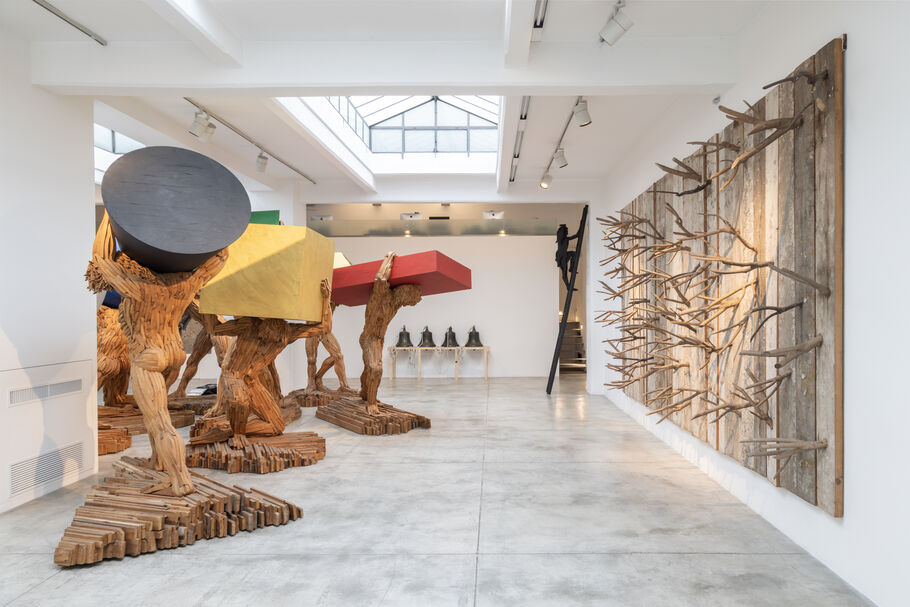
Installation view of “Mario Ceroli: La Meraviglia” at Cardi Gallery, Milan. Photo by Fabio Mantegna.Courtesy of Cardi Gallery.
Whether you’re planning a post-Biennale stopover, a trip for the Salone del Mobile furniture fair, or simply seeking a stylish getaway, this guide offers an overview of the city’s many offerings, with an eye towards collectors. Based on insider intel from the city’s gallerists, we share below a look at the galleries, museums, hidden gems, watering holes, eateries, and Design Week haunts that are not to be missed.
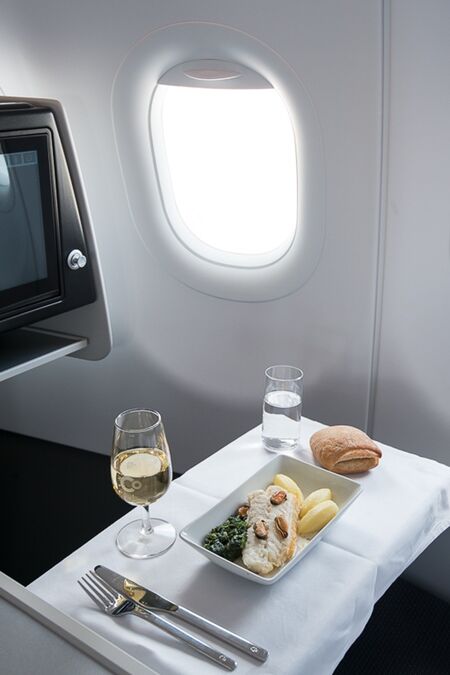

Courtesy of La Compagnie.
Courtesy of Hotel Principe di Savoia.
There’s no dearth of transportation options that will get you to get to Milan wherever you are coming from. Yet, for those coming from the U.S. and with collecting plans in mind, consider one of the six weekly flights from New York to Milan via La Compagnie.
The boutique, all-business-class airline launched its Milan route in 2022, in response to its growing clientele from the art and fashion worlds. (It now accounts for around 20% of all travelers flying between New York and Milan.) While La Compagnie’s premium accommodations and relatively affordable fares for business class—bespoke planes boast 76 lie-flat seats, and round-trip flights start at $2,400—would appeal to almost anyone, its ample baggage allowance is particularly enticing for collectors.
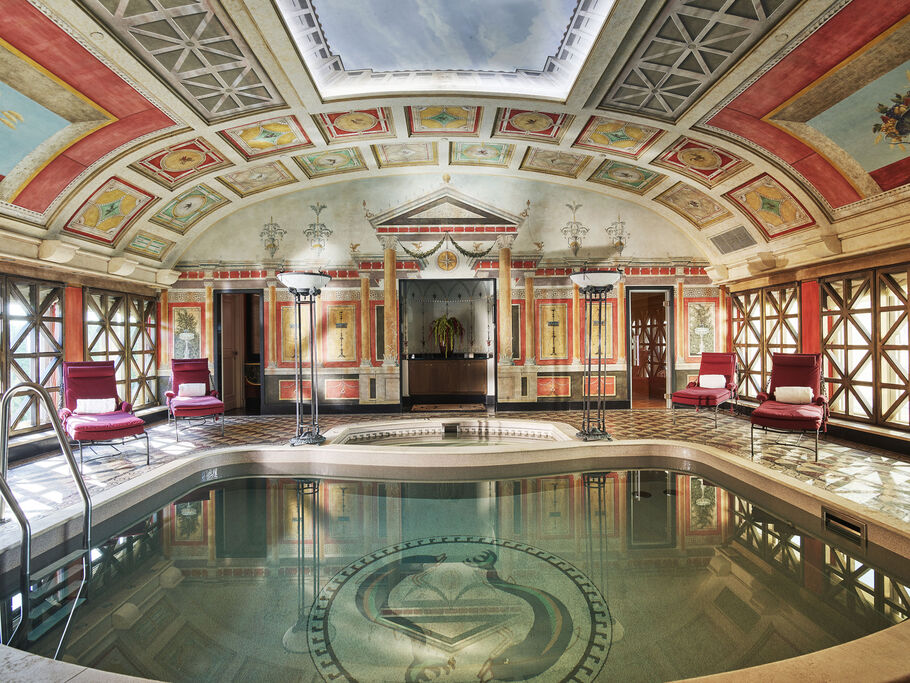
The pool in the Presidential Suite at Hotel Principe di Savoia. Courtesy of Hotel Principe di Savoia.
That same clientele often gravitates to Principe di Savoia hotel, overlooking the verdant Piazza della Repubblica. “The hotel is highly recognized by art professionals who appreciate the classical atmosphere of the decor and the Italian charm,” said Ezio Indiani, Principe di Savoia’s general manager. Indeed, the five-star hotel has Italian charm in spades—rich wood paneling, marble, and Murano glass chandeliers are aplenty. The palatial Presidential Suite, which is known to host celebrities, even has an indoor, fresco-filled swimming pool.
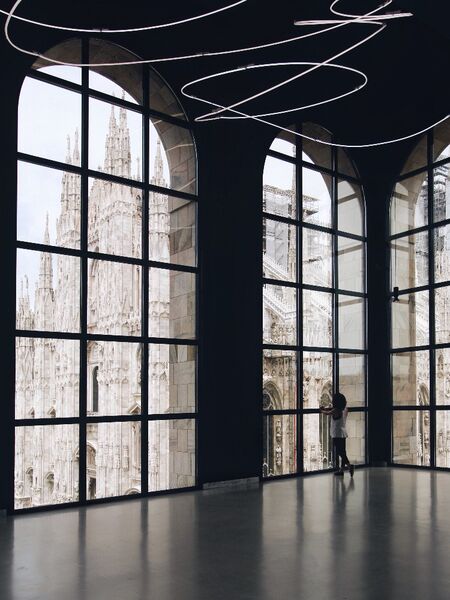
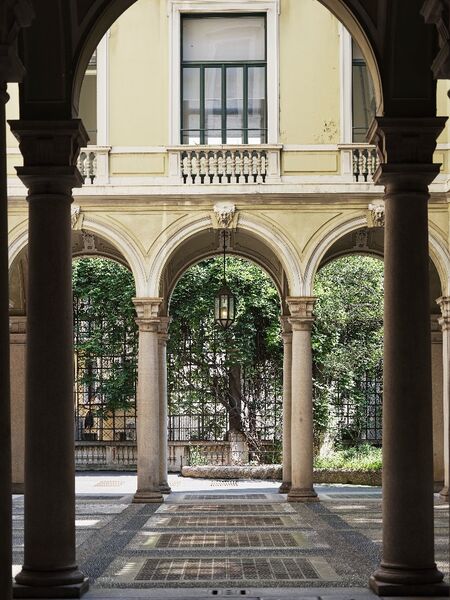
Museo 900, a stop on the Lucio Fontana art trail led by Hotel Principe di Savoia. Courtesy of Hotel Principe di Savoia. Courtesy of Hotel Principe di Savoia.
Brera courtyard, a stop on the Lucio Fontana art trail led by Hotel Principe di Savoia. Courtesy of Hotel Principe di Savoia. Courtesy of Hotel Principe di Savoia.
Principe di Savoia also offers a thoughtfully curated walking tour with art consultant Olympia Isidori, who leads guests through the city’s storied Brera District, tracing the footsteps of Lucio Fontana—from his preferred bar to the shop where he bought his canvases.
“Milan was home for Fontana—there is so much synergy between his revolutionary work and the city’s energy that there was no doubt the trail should be designed around him,” Isidori explained. “The trail is the perfect opportunity for both art and design collectors to explore the city’s avant-garde spirit against the backdrop of its historic corners.”
Isidori added that the hotel is an ideal launchpad from which to base an art-filled trip to Milan, “easily reaching hidden gems like Casa Boschi di Stefano (if you ever wondered what living with a room full of artworks by Fontana’s feels like, look no further) as well as the magical Brera district brimming with events during Design Week and the city’s galleries putting up some of their best shows during Miart. The hotel comes to life at each of these Milanese weeks, and you get a real sense of effervescent energy in the air.”
Milan galleries
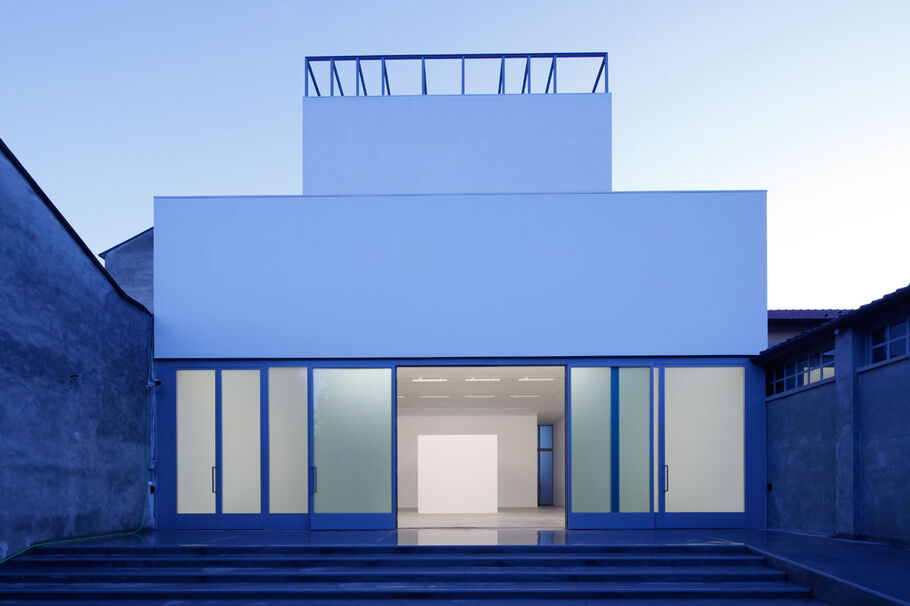
Exterior view, Lia Rumma, Milan. Courtesy of Lia Rumma.
“Historically, Milan has been regarded as a design capital, but that perspective is shifting with the opening of new contemporary art museums and galleries, and with the evolution of regional art fairs like Miart,” said Jessica Kreps, a partner at Lehmann Maupin, which is opening a pop-up space in the city this month. The city is often “overlooked in favor of Rome, Florence, or Venice,” added Beatrice Pesenti. “But I think it’s the best of them all, offering something for everyone.”
Various gallerists note that the Milan art and design scene is growing—from its expansion into neighborhoods including Chinatown, Isola, Lambrate, Nolo, Loreto, and areas from Porta Romana to Corvetto; to the ever-evolving cross-contamination between art and design; to increasing internationalization.
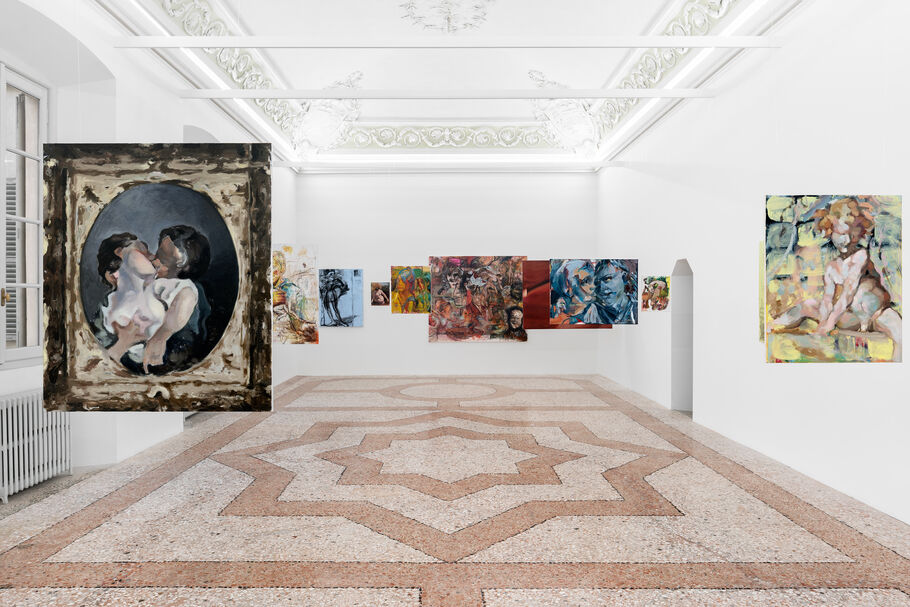
Installation view of “Daniele: Toneatti: Brand New Love” at Peres Projects, Milan. Photo by T-space. Courtesy of Peres Projects.
“Milan is attracting a range of new local and international galleries,” Isidori noted, nodding to Berlin’s Peres Projects, which opened its Milan space in 2022, and now the new Lehmann Maupin pop-up. The latter leverages the city’s vibrant art scene alongside significant moments for its artists in Italy, such as Nari Ward’s retrospective at HangarBicocca and several artists’ participation in the Venice Biennale.
“We’re always looking for opportunities to grow our artists’ exposure in Europe,” Kreps said, emphasizing Milan’s appealing, unique position at the intersection of design, fashion, and art. “The architecture of the city really lends itself to the feeling of discovery; everything is hidden.”
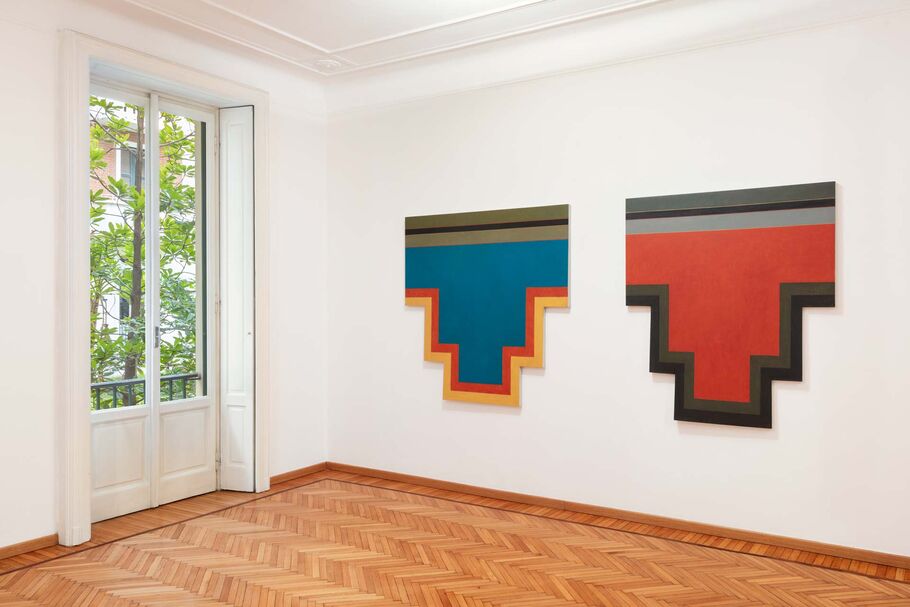
Installation view of Eun-Mo Chung at Monica de Cardenas, Milan. Photo by Andrea Rossetti. Courtesy of Monica de Cardenas.
Lehmann Maupin’s temporary outpost is located at the arts venue Circolo, which was founded by Nicole Saikalis Bay, a Milanese arts patron and longtime supporter of the gallery. This collaboration is envisioned to draw both local and international crowds.
All that said, Milan’s robust gallery scene is not new—a slate of stalwart galleries have long been championing artists, from 20th-century greats to young, emerging talents.
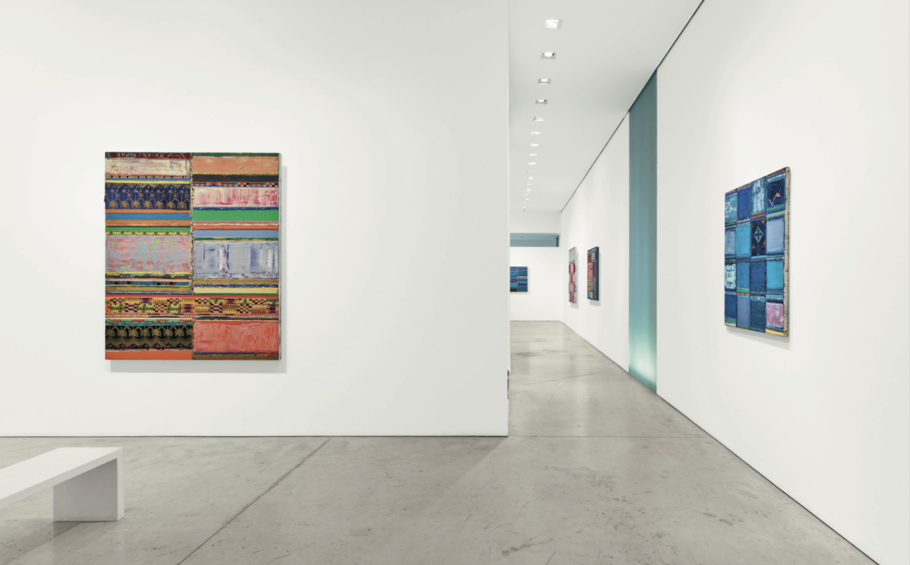
Installation view of “Tegene Kunbi: Patchwork Freedoms” at Primo Marella Gallery, Milan. Courtesy of Primo Marella Gallery.
Here, we share more about a few of our favorite Milan galleries:
- Lia Rumma: Founded in Naples in 1971, the gallery expanded to Milan in 1999 and has been pivotal in promoting the Arte Povera, Minimalist, Land Art, and Conceptual Art movements, plus international artists like Joseph Kosuth and Marina Abramović. The Milan gallery opened in 2010 in a purpose-built space in the Cenisio district. “The exhibitions are conceived by the artist together with the gallery owner Lia Rumma, always creating a path through the three floors by setting up museum-like exhibitions,” said gallery manager Francesco Valli.
- Primo Marella Gallery: Since its inception in 1992, Primo Marella Gallery has focused on showcasing rising artists and movements from outside of Europe. “The focus of the gallery’s programs has touched different emerging areas, starting with China in the late ’90s, then India and South East Asia to, more recently, Africa, always with the precise goal to pioneer in the presentation of such complex and constantly evolving artistic scenes,” said Daniele Marella, the gallery’s sales and marketing manager.
- Cardi Gallery: Established in Milan in 1972 by Renato Cardi and now led by his son Nicolo, Cardi Gallery champions Italian modern, post-war, and contemporary art, with strong expertise artists of Arte Povera, Minimalism, and Group Zero. Given this historical weight, the gallery can be counted upon for museum-quality exhibitions.
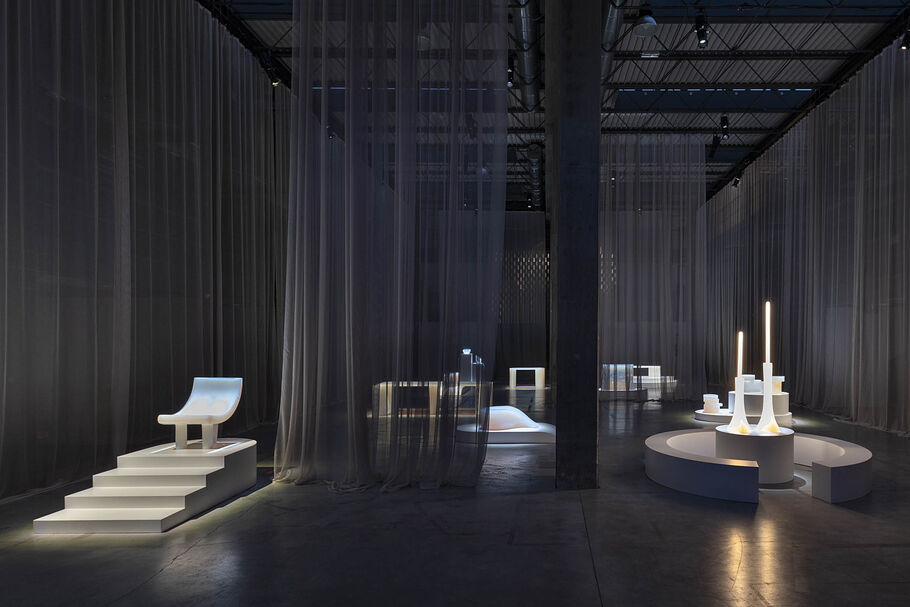
Installation view of “The Bright Side of Design - Milan Design Week 2023” at Nilufar Depot, Milan. Photo by Ruy Teixera. Courtesy of Nilufar Gallery.
- Monica de Cardenas: Operating for over 30 years, Monica de Cardenas began in the gallerist’s apartment in the 1990s. “The gallery is still there today, and over the years expanded to include some of the apartments around it,” said director Beatrice Pesenti. “It’s a unique space that stands out among the rest.”
- Nilufar Gallery: Under the vision of Nina Yashar, Nilufar Gallery has established itself as a leading venue in Milan for modern and contemporary design, showcasing a blend of historical and contemporary works. In addition to its gallery in the center of the city, the vast Nilufar Depot near Garibaldi station is a must-visit destination, combining fresh exhibitions with a sprawling network of alcoves filled with cutting-edge design.
- MASSIMODECARLO: With locations in Milan, London, Hong Kong, and Paris, MASSIMODECARLO is renowned for its influential contemporary program, filled with leading artists and promising talents—so it can be counted upon for standout shows. Plus, the Milan gallery space itself is a delight, housed in an 18th-century palazzo building replete with its original tiling, wood paneling, sea green marble, fireplaces, and wall murals.
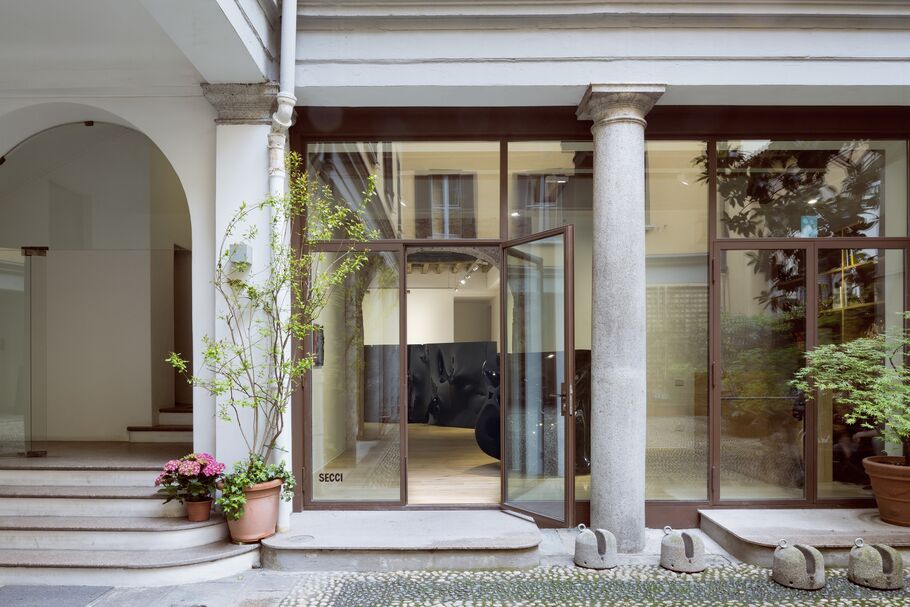
Installation view of “Gio’ Pomodoro: opere in poliestere,” 2023, at Secci Gallery, Milan. Photo by Maniero Stefano. Courtesy of the artist and Secci Gallery.
- Secci: Located near Piazza Sant’Alessandro and just blocks from the Duomo, Secci can be counted upon for strong, cutting-edge shows, with an eye towards Conceptual and Minimalist art. At the same time, the gallery has also been known to discover and elevate fresh, emerging and midcareer artists.
- The Flat - Massimo Carasi: The Flat - Massimo Carasi in Porta Venezia is committed to experimentation, research, and three-dimensional works. “We sometimes find ourselves on ground that could be common with innovative research design,” said Daniela Barbieri, co-owner and director. “With the aim of stimulating curiosity and surprising the collector, the gallery provides an unexpected vision, where visual-perceptual ambiguity prevails.”
- ABC-ARTE: “ABC-ARTE supports artists who experiment with different languages and formats, with a predilection for gestural abstraction,” said director Antonio Borghese. With the opening of its second space, ABC-ARTE ONE OF, the gallery is embracing young artists from across the world.
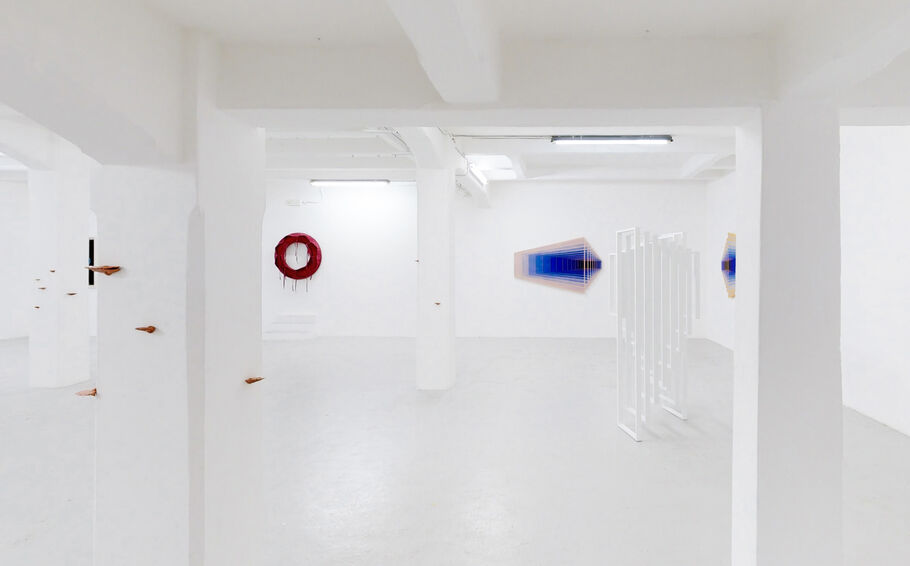
Installation view of “Altered Perceptions,” 2023, at The Flat - Massimo Carasi, Milan. Courtesy of The Flat - Massimo Carasi.
- Andrea Ingenito Contemporary Art: Founded in Naples in 2008, Andrea Ingenito Contemporary Art is focused on promoting artists and movements of the 1960s and ’70s, alongside selected contemporary artists, through exhibitions and collaborations with institutions and art fairs. Its Milan space, which opened in 2013, is based between Corso Buenos Aires and Central Station.
- Dep Art Gallery: “Dep Art Gallery’s focus is on presenting Italian and foreign artists, with a special emphasis on those of the 1960s and ’70s, but also on the future generations,” said gallery founder Antonio Addamiano. The gallery, located near Porta Romana, maintains a curatorial approach that is focused on emphasizing its artists’ historical importance.
Museums and institutions in Milan
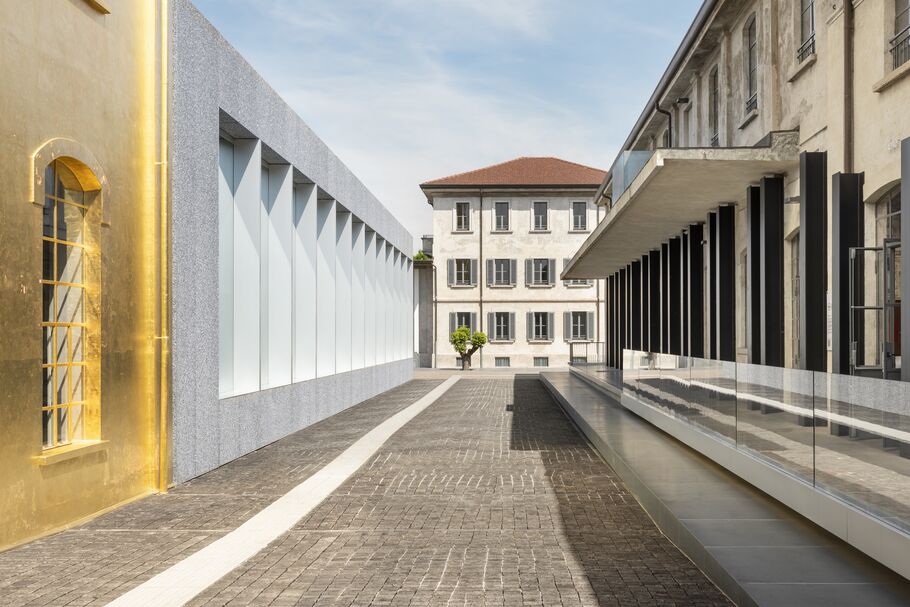
Fondazione Prada, Milan venue. Architectural project by OMA. Photo by Alessandro Saletta and Agnese Bedini - DSL Studio. 2020 Courtesy Fondazione Prada.
Like any great art city, Milan has a commercial gallery scene that is complemented by a vital network of museums and institutions. The city’s art and design landscape is richly diverse, spanning cutting-edge contemporary spaces and historic venues that preserve the city’s deep cultural roots.
Some of our insiders’ favorites include:
- Fondazione Prada: The most-cited place to see contemporary art in the city, the fashion house’s grand contemporary art campus is essential to any art trip to Milan. Renowned for its ambitious exhibitions and architectural spaces, Fondazione Prada also boasts a permanent collection of installations by heavyweights like Louise Bourgeois and Robert Gober, and a perennial favorite: the topsy-turvy fungi room of Carsten Höller.
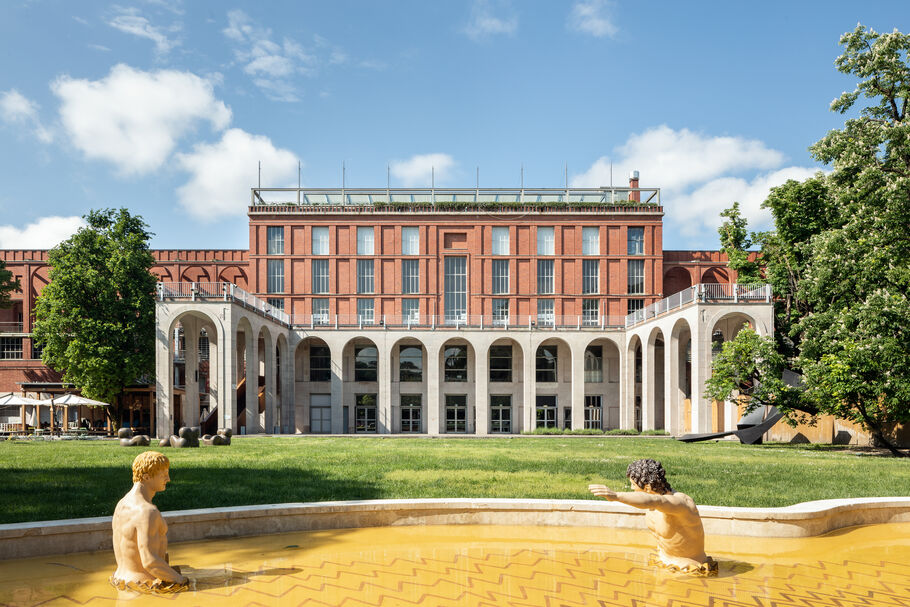
Triennale, Milan. Photo by Gianluca Di Ioia.© Triennale Milano.
- La Triennale di Milano: “The grand dame of Milan’s design scene,” Nicolo Cardi noted, “the Triennale: an extensive art and design museum in the central Parco Sempione. The institution has recently brought a fresh look to its historic Museo del Design Italiano (Museum of Italian Design) on the ground floor, with a selection of new objects and a new layout guiding visitors through the evolution of Italy’s design culture from the 1920s to the present day.” Daniela Barbieri considers the museum “the perfect combination of art and design in Milan,” and tells us not to miss the Giorgio de Chirico fountain and outdoor sculptures.
- Pirelli HangarBicocca: Set in a former industrial hangar, the nonprofit Pirelli HangarBicocca is revered for impressive exhibitions of leading contemporary artists, like Nari Ward and Anselm Kiefer. The sprawling venue offers artists a space to experiment on a large scale.
- Museo del 900: Located on the Piazza Duomo, this museum is dedicated to 20th-century art and offers an overview of Italian and international art movements.

MUDEC, Milan. Courtesy of MUDEC.
- MUDEC: While safeguarding the Milan City Council’s ethno-anthropological collections, the museum puts on dynamic international exhibitions that transcend traditional art forms. Inviting engagement with and exploration of global cultures, MUDEC’s programming spans visual art, performance, sound, design, and costume.
- Casa Museo Bagatti Valsecchi: This historic house museum offers a glimpse into Renaissance revival architecture and the lavish lifestyle of the Bagatti Valsecchi family. It’s filled with an impressive collection of Renaissance art.
- Casa Boschi Di Stefano: “A real gem,” according to Antonio Borghese, this intimate house museum is filled with a dazzling collection of 20th-century Italian art, offering a glimpse into a beautifully preserved, art-centric Milanese home.
Where to avoid the crowds in Milan
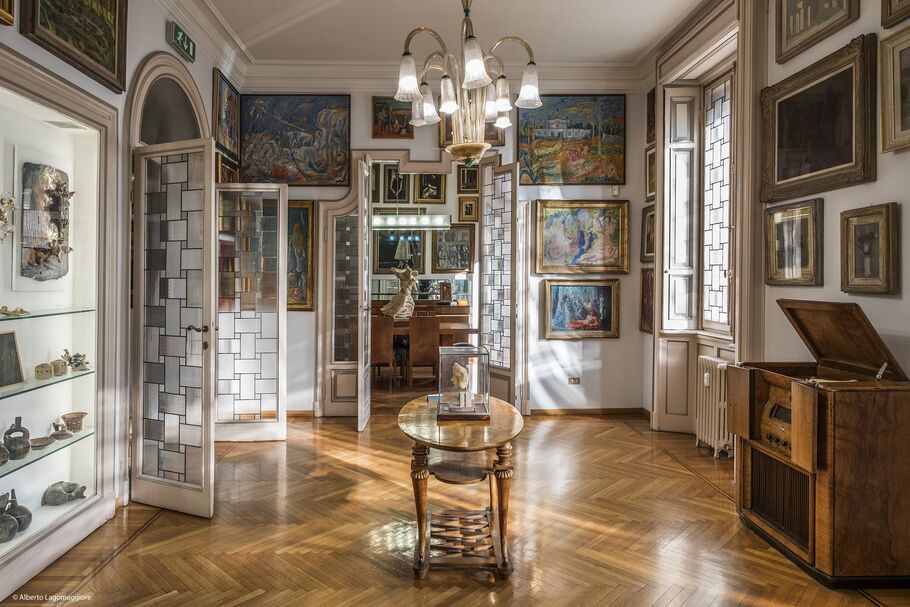
Interior view of Casa Museo Boschi di Stefano. Courtesy of Casa Museo Boschi di Stefano.
Milan’s labyrinthine streets and historic courtyards behold a wealth of lesser-known venues and areas, often overshadowed by the city’s more touristy spots. Here, Milanese gallerists share their favorite places off the beaten path.
- Monumental Cemetery: One of the two largest cemeteries in the city, with many tombs designed by notable artists such as Lucio Fontana, Medardo Rosso, and Adolfo Wildt. Francesco Valli describes it as “a real open-air museum to discover the history of Milan.”
- I Chiostri di San Barnaba: Nicolo Cardi calls these cloisters of the San Barnaba Church a “green oasis in the center of the city” that is perfect “to discover a timeless Milan.”
- Laboratorio Paravicini: “Located near the Duomo area, it’s an ancient bottega run by a team of talented women with a history of excellence in the creation of hand-decorated ceramics,” noted Ezio Indiani. “Laboratorio Paravicini interprets the tradition of high Italian craftsmanship. Visiting this place is like taking a dive into the past of the great Milanese artisan tradition. Everything is bespoke, everything is produced by hand with care and with the slowness that the work of art requires.”
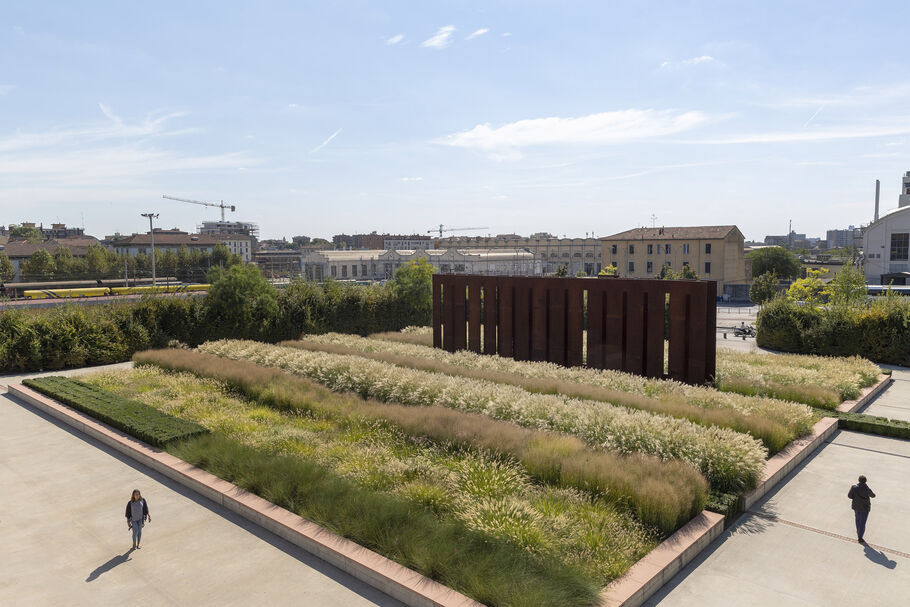
Outdoor spaces of the Pirelli HangarBicocca. Photo by Lorenzo Palmeri. Courtesy of Pirelli HangarBicocca.
- Corso Sempione: “The area of Corso Sempione and Arco della Pace is very attractive, but it also has a beautiful park rich in vegetation that allows pleasant walks,” said Andrea Ingenito. “This park is very well known to the Milanese people but not so much to visitors.”
- Cinque Vie district: “I’ve always had a soft spot for the ‘Cinque Vie,’ one of the oldest districts in Milan, outlined by five streets very close to the Duomo,” said Beatrice Pesenti. “Here, you’ll find antique shops, small ateliers, [and] design and clothing boutiques. The significance for me is that during World War II, many parts of Milan were flattened by the bombardments, but this area was mostly spared. Seeing the vecchia (old) Milano and how it once was is always special.”
- Villa Necchi Campiglio: Antonio Addamiano recommends this hidden gem. Not overly touristy, this stunning home provides a glimpse into Milan’s luxurious modernist past, surrounded by serene gardens, in the middle of the city. The beautiful space has appeared in multiple movies, such as Luca Guadagnino’s I Am Love (2009).
- Villa Invernizzi: This private residence is known for the unexpected occupants of its garden: flamingos.
Eating and drinking in Milan

Interior view of Bar Basso. Courtesy of Bar Basso.
From morning coffee to the classic Milanese aperitivo drinks ritual, our insiders share their favorite spots for drinking and dining.
For coffee and sweets:
- Aroma Napoletano: “The best coffee in Milano,” according to Daniele Marella.
- Sissi: “My local coffee and brioche ritual takes place at Sissi, whilst renowned Marchesi and Sant’Ambroeus are regular haunts,” Olympia Isidori noted.
- Pasticceria Cuchi: Recommended by Jessica Kreps for “a coffee and treat in old world Milano.”
- OSLO: A newcomer serving up fluffy angel cakes and ice cream.
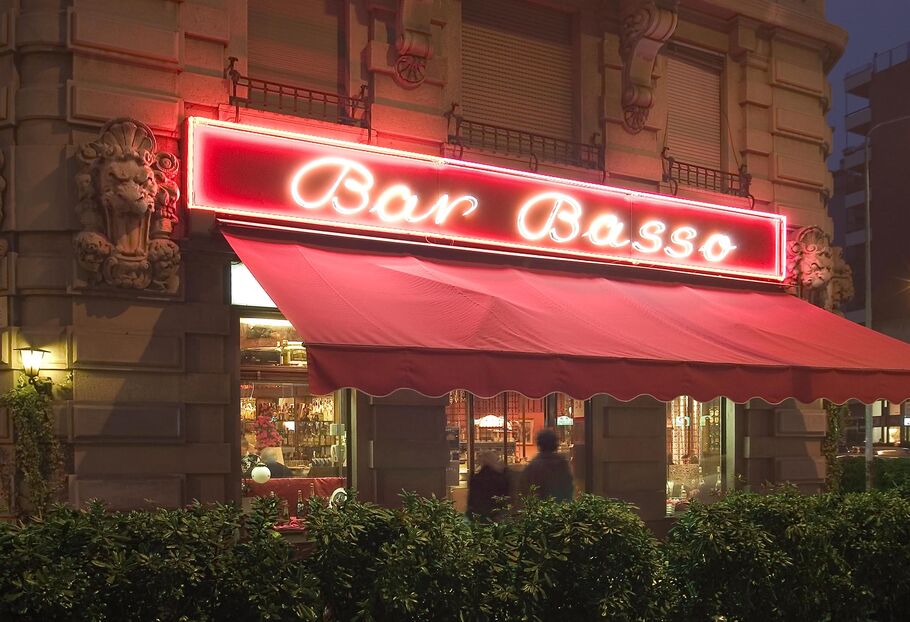
Exterior view of Bar Basso. Courtesy of Bar Basso.
For drinks and aperitivo:
- Bar Basso: By and far, Bar Basso tops this list. “For the real Milanese aperitivo you have to go to Bar Basso,” said Francesco Valli. Considered the cornerstone of Milanese aperitivo culture, Bar Basso is known for the invention of the negroni sbagliato.
- Bar Paradiso: Francesco Valli and Olympia Isidori also mentioned Paradiso among newer, favorite spots where “the art and fashion crowds often rub shoulder to shoulder.”
- Bar Jamaica: This historical spot in the Brera district has been an art world haunt for generations.
- Camparino: Another option for an authentic Milanese aperitivo is this home of the famous bitter liqueur Campari. With its famed location in the bustling Galleria, one must “stand at the counter to truly blend in with the locals,” Olympia Isidori advised.
- Felix Bar: This idyllic setting for an aperitivo offers views of the Navigli canals.
- Principe Bar: Located within Principe di Savoia, this stately bar offers “bespoke cocktails in a cool contemporary venue,” said Ezio Indiani. A buzzy spot during Milan’s Fashion and Design Weeks, the intimate space is topped by a spectacular Murano chandelier made from hundreds of pieces of glass.
- Cantine Isola: Jessica Kreps recommends this spot in Chinatown for casual after-dinner drinks.
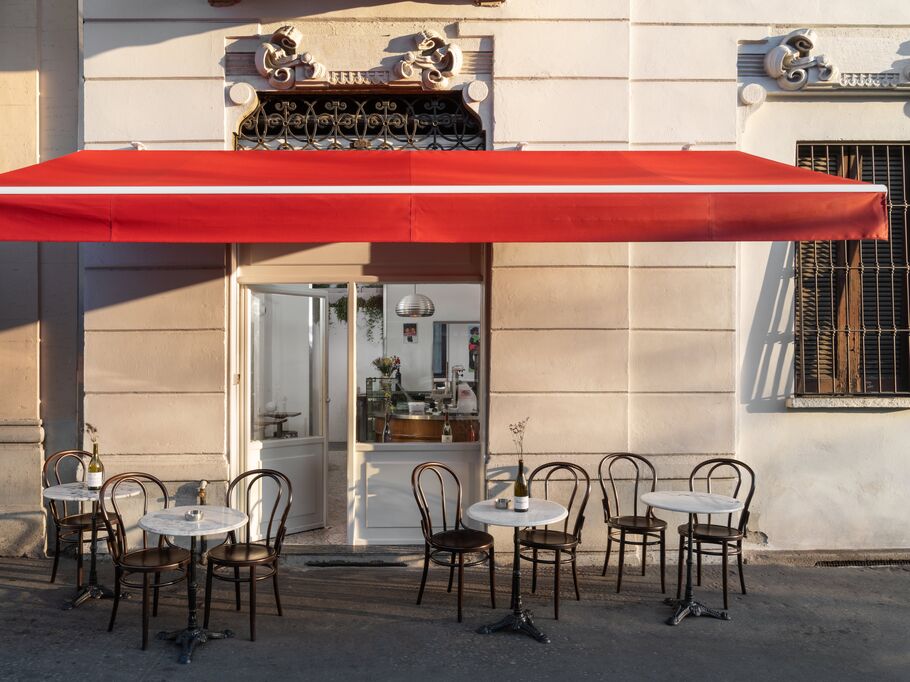
Bar Paradiso, Milan. Photo by Delfino Sisto Legnani. Courtesy of Bar Paradiso.
For classic Milanese cuisine, like risotto Milanese and Cotoletta alla Milanese (veal), our sources point to these favorites:
- In Brera: Solferino and La Libera.
- In Navigli: Macelleria Pellegrini and Trattoria Madonnina.
- In the City Center: Da Giacomo, which has stunning views of the Duomo.
- In the Corso Como area: Antica Trattoria della Pesa.
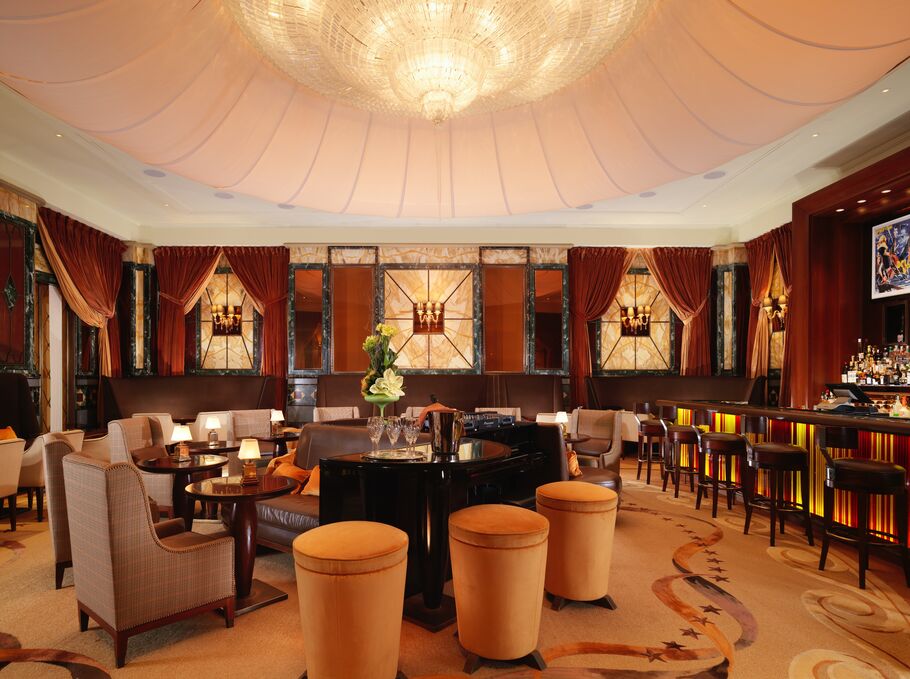
The Principe Bar at Hotel Principe di Savoia. Courtesy of Hotel Principe de Savoia.
More recommended restaurants:
- Trattoria Torre di Pisa: One of the oldest restaurants in the city, this Tuscan restaurant located in Brera is a favorite of Nicolo Cardi.
- Rovello 18: Offering a modern take on Milanese cuisine in the Brera district, this “more relaxed rosticceria” is recommended by Olympia Isidori.
- CreDa: “For lunch and dinner go to CreDa, to taste a corner of Naples in Milan!” noted Francesco Valli. Located in Navigli, the restaurant serves up authentic Neapolitan pizza.
- e/n enoteca naturale: A favorite of Antonio Addamiano and Antonio Borghese, this restaurant, located in the city center, is known for its natural wines.
- 10 Corso Como: The shopping and dining complex is a good spot for lunch or coffee, Daniele Marella noted.
- Trattoria del Ciumbia: Designed by Dimorestudio, this trattoria is an ode to the art-world haunts of the 1960s Brera district.
- Erba Brusca: Located in the Navigli district, this spot is especially charming in the spring and summer months. “Part of its charm is its outdoor vegetable garden and seasonally inspired dishes,” Jessica Kreps said.
- Two fine dining options that Kreps also recommends are Il Salumaio di Montenapoleone in Brera and Langosteria in the Navigli District.
Where to hang out during Milan Design Week

Isola Design Festival 2024, “This Future is Currently Unavailable.” Courtesy of Isola Design.
During Salone del Mobile and the countless exhibitions and activations of Design Week that fill the city, it’s hard to miss the art and design crowd. To help narrow down where to spend your time, gallerists point toward three main hubs.
- Brera District: The heart of Milan’s design culture and history, Brera is filled with galleries, shops, and bars. Francesco Valli noted that “the busiest districts during Design Week and Art Week are Isola and Brera, but the whole city comes alive.”
- Isola District: “In the last few years, the ‘Isola’ district has become a central and very important place for art and design,” said Daniele Marella. “With its new ‘life,’ this part of Milan has become really interesting, especially for the younger generation, and you can definitely feel the ferment in the streets. Every year during the Salone del Mobile, the Isola district proposes Isola Design, which highlights all the events and venues that take place in the area.”
- Tortona District: “Tortona attracts designers and enthusiasts with its converted warehouses and industrial spaces showcasing cutting-edge design installations and pop-up shops,” said Antonio Borghese. Andrea Ingenito added, “During the design week, one of the coolest places is always the area of Via Tortona, where everybody usually meets.”
